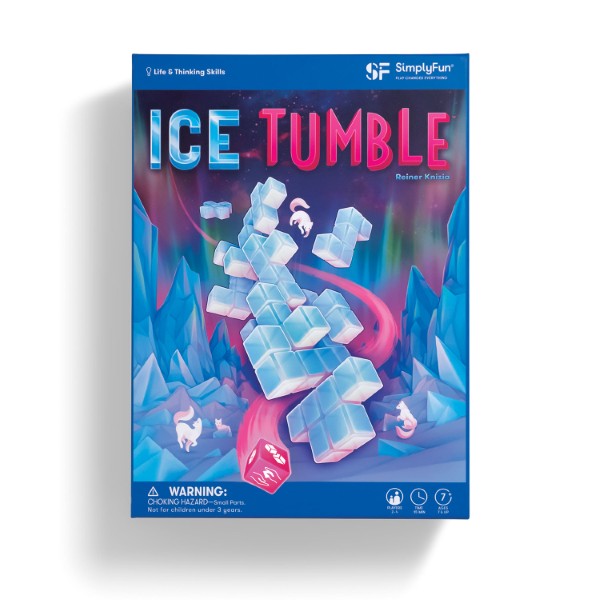
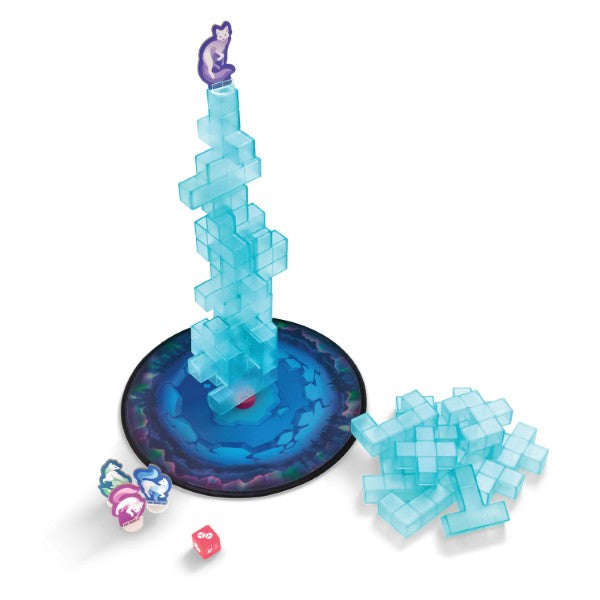
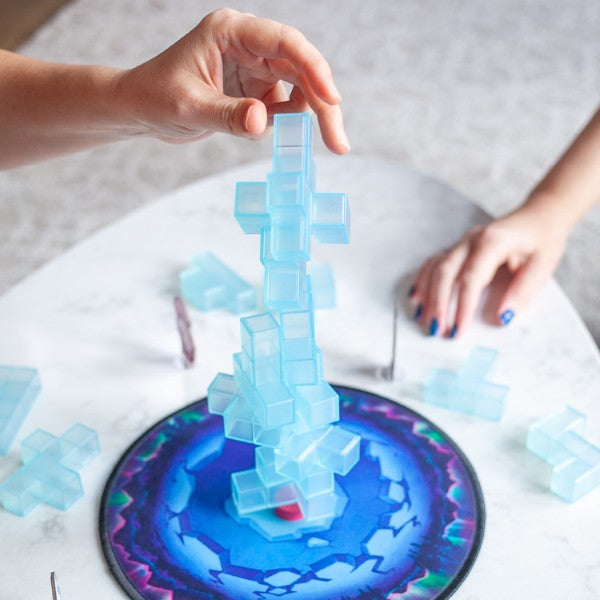
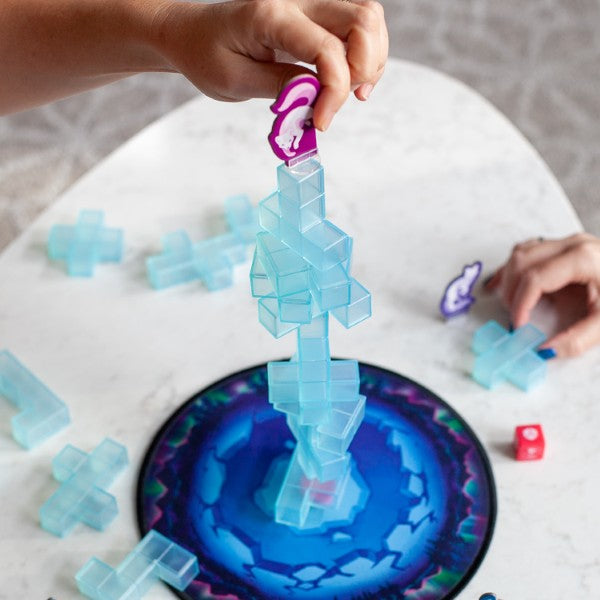


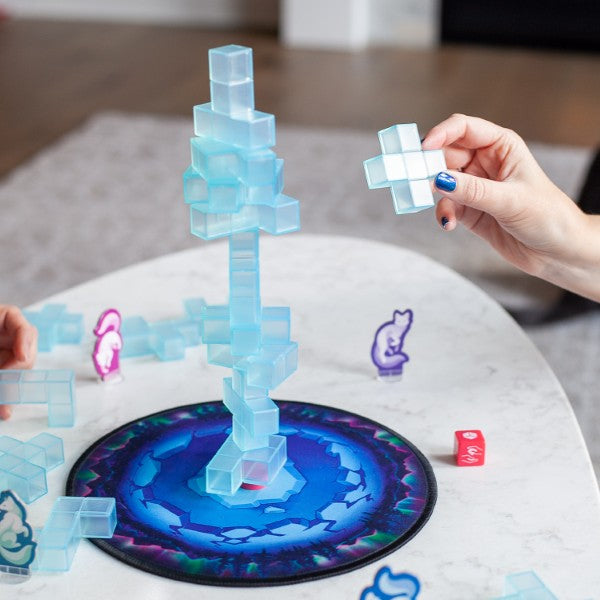
Collapsible content
A game where players compete to be the first to successfully place all their ice blocks and then their fox pawn on the sculpture.
You can play Ice Tumble with 2-4 players, ages 7 and up.
Ice Tumble is good for developing Spatial Reasoning Skills as players determine how and where to place their blocks on the sculpture so they will not tumble off.
Ice Tumble also helps with Fine Motor Skills as players using only one hand carefully collect and then place their ice blocks on the sculpture while trying to keep it balanced.
Players take turns rolling the die and collecting ice blocks. Then they carefully stack their blocks on the sculpture without any falling off. The first player to successfully place all their ice blocks and their fox pawn on the sculpture wins the game!
Phase 1 – Collecting Ice Blocks
• Place the game mat in the center of the play area.
• Then place all the ice blocks in a pile on the mat.
• Each player chooses a fox pawn and places it in front of them.
The ice blocks come in a variety of shapes and sizes.
Some will be easier or more difficult to balance. *
The starting player rolls the die and takes one of the following actions:
If your roll reveals one block, remove one ice block from the pile and place it in front of you.
If your roll reveals two blocks, remove two ice blocks, one at a time, and place them in front of you.
If your roll reveals the hands icon, take one ice block from another player who has blocks. If no other player has blocks, then nothing happens.
You may only use one hand and may touch only the block that you are removing.
When taking a block, no other blocks in the pile can move. If any other block moves even slightly, take one additional block as a penalty.
After you have taken your action on the die, play continues clockwise until all the blocks are cleared.
When the last block is removed from the middle, Phase One is completed.
Now that the game mat is cleared, Phase Two begins on the next player’s turn.
Phase 2- Building a Sculpture
Before building begins, players choose one of the two platforms and place it in the middle of the mat.
The larger platform will make for an easier game and the smaller platform will make for a harder one.
The next player rolls the die and takes one of the following actions:
If your roll reveals one block, place one of your blocks onto the sculpture.
If your roll reveals two blocks, place two of your ice blocks onto the sculpture, one at a time.
If your roll reveals the hands icon, give any one of your ice blocks to another player of your choice.
You may only use one hand and may touch only the block that you are stacking. Blocks should be stacked one at a time.
The ice blocks need to be stacked onto the platform or the sculpture so that no blocks touch the game mat.
If any part of the sculpture tumbles when you are stacking your ice blocks, place all fallen blocks back into the box.
If you are still holding a block, then it also goes back into the box.
Then, as a penalty, take any two blocks from the box.
Ice blocks that are still part of the sculpture’s structure remain in play.
This concludes your turn and play progresses clockwise to the next player.
Once a player has successfully placed all their ice blocks, on the same turn they then place their fox pawn on the sculpture to win the game. If any blocks tumble when the fox is placed, move all fallen blocks back into the box. Then, as a penalty, take any two blocks from the box and place them in front of you. Play continues clockwise to the next player.
The first player to successfully place all their ice blocks and stack their fox pawn on the sculpture without it tumbling is the winner.
The ice blocks can be slippery, so be careful or they could all come tumbling down in Ice Tumble.


Core Standard* Math
Math
- Mathematical Practice
- Reason abstractly and quantitatively. Grade Levels 2nd, 3rd
- Geometry
- Reason with shapes and their attributes. Grade Levels 2nd, 3rd


Explore
What Does Child Do To Use Skill In The Game?
Ice Tumble requires players to closely examine the spatial orientation of ice blocks, their relationship to other blocks and balance options.
How Parents Can Assist Learning
Parents can ask children to walk around the ice pile or sculpture. This teaches children to explore and think before acting.
Parents can also encourage children to explore the orientation of their blocks and varying ways to place a block on an ice sculpture. This will help them learn about the different balance effects of placing cubes in various locations.
Learning Implications and Educator Support
Exploration is a fundamental learning process, and this game is particularly good at helping children learn to examine carefully.
Additionally, Ice Tumble helps children think about inter-relationship among parts. How does one thing I do result in something I do not expect? Many fine motor games, including construction and puzzle solving require this type of study.
Educators can encourage children to think about various aspects: relationship of blocks in ice pile, placement of blocks for offensive or defensive purposes, carefulness of movement, etc.
Determine
What Does Child Do To Use Skill In The Game?
Players need to decide which block to remove from ice pile that will not make other blocks move. When building the ice sculpture, players need to decide which block to place, in what orientation, and where to place it on the sculpture.
How Parents Can Assist Learning
Prompt children to look closely at relationship of blocks, and try to remember what happened on prior moves (ex: did blocks move, did any blocks fall so there is a more solid foundation, etc.) to help them decide what is best option for their move.
Also, parents can verbalize their own strategy, so children can learn by hearing what others think and then observe the consequences.
Learning Implications and Educator Support
Strategy games or activities like Ice Tumble requires anticipation of consequences, which in turn requires analysis of the specific aspects of the situation. Prompt children to remember what happened on prior moves (ex: did blocks move, did any blocks fall so there is a more solid foundation, etc.) to help them decide what is best option for their move.
Also, adults can verbalize their own strategy, so children can learn by hearing what others think and then observe the consequences.
Compare
What Does Child Do To Use Skill In The Game?
In round one of the game, players will compare blocks in effort to find the blocks they want to play round two. During round two, players compare how different blocks may be placed on an ice sculpture as part of determining which block to play and where. They also compare the results of playing a block relative to the placement of prior blocks.
How Parents Can Assist Learning
Parents can encourage children to compare their actions to determine what was successful. Why did removing a block from ice pile cause other blocks to move, or why did placing a block on the sculpture cause it to collapse or not?
Learning Implications and Educator Support
Comparing in Ice Tumble helps children learn situational analysis because they need to consider and compare the consequences of playing a certain block in a certain location, or removing a block without causing others to move.
For younger players, educators may need to remind them that blocks can be rotated to determine best orientation for placement on top of or within an ice sculpture. They can ask children questions to encourage them to make comparisons, such as, "Which block is smallest? Which is largest?" or, "Can you see a spot to place your block on the side of the ice sculpture?"
Verbalizing is a good technique for strengthening the child's analytical abilities and problem-solving.
Remember
What Does Child Do To Use Skill In The Game?
While not a memory game, Ice Tumble does involve some memory as players will recall what worked or did not work on prior moves and games.
How Parents Can Assist Learning
Personal experience of success or failure reinforces what to do or not do in future situations. These experiences may generalize to other games and situations. Especially when children make a mistake, adults can ask them to remember the turn where they had more success. Ask, "What did you do then?"
Learning Implications and Educator Support
Personal experience of success or failure reinforces what to do or not do in future situations. These experiences may generalize to other games and situations. Especially when children make a mistake, adults can ask them to remember the turn where they had more success. Ask, "What did you do then?"
Predict
What Does Child Do To Use Skill In The Game?
Players are predicting with each turn whether removing a block from an ice pile will cause others to move, or adding a block to the ice sculpture will cause others to fall. With experience with the game, players will be able to predict the likelihood of success on any particular turn.
How Parents Can Assist Learning
The experience with this game may help children think ahead and be more cautious before acting. This is particularly true if parents reinforce the learning. For example, "Remember what happens if you don't think ahead. The sculpture falls down."
Additionally, parents can ask children to predict what will happen on their turn. This will help children think more carefully and be less impulsive.
Learning Implications and Educator Support
Playing Ice Tumble helps children develop spatial reasoning skills, situational analysis, risk assessment and perspective changing, all skills that can be used to make more accurate predictions of opponents' moves. Additionally, making predictions requires analysis, observation, empathy and interpretation.
Ask children to predict what will happen if s/he removes or places a block. After s/he places, discuss what happened. Discussing consequences help children learn what worked and did not work, which in turn helps them make better predictions in the future.
Plan
What Does Child Do To Use Skill In The Game?
There is little planning in Ice Tumble because the ice pile and sculpture change on each turn, making it challenging to plan ahead.
How Parents Can Assist Learning
Parents can encourage children to take their time, look over the whole pile or sculpture, and make a plan for what they will do on their next turn.
Learning Implications and Educator Support
Children will often have their eye on a block they want or spot on the ice sculpture they want to use, only to have another player pick their block, use the sculpture spot, or cause the sculpture to partially collapse. Educators can encourage children to think of more than one option for their next turn. This will build foresight and confidence.
Experiment
What Does Child Do To Use Skill In The Game?
Players will likely try different strategies for building the ice sculptures such as growing tall, going wide, or making risky balances.
How Parents Can Assist Learning
Experimentation is integral to Ice Tumble, as each turn provides an opportunity for children to think about and try different blocks in different locations prior to making a move.
Children who try different approaches and find what works are more successful than children who are impulsive. Parents can reinforce children's efforts to try something different when the previous approach failed.
Learning Implications and Educator Support
Experimentation is integral to Ice Tumble, as each turn provides an opportunity for children to think about and try different blocks in different locations prior to making a move.
Educators can discuss different strategies, such as trying to make the sculpture tall versus compact. Prior to starting the game and encourage the child to select one. Play the game and discuss. Then, play again with the child trying a different strategy. Discuss again and compare the advantages and disadvantages.
Practice
What Does Child Do To Use Skill In The Game?
Ice Tumble allows players to practice their fine motor, balance and spatial reasoning skills. The more you play, the more your skills will advance which in turn allows you to try more advanced balance moves and strategies.
How Parents Can Assist Learning
No specific parental support required.
Parents can encourage children to play solo, stacking blocks to make may different sculptures. This will allow them to practice without calling it "practice".
Learning Implications and Educator Support
Practice is needed to learn any skill.
Educators can reinforce the child's increasing fine motor and perception skills, such as for identifying places to places more or less symmetrical blocks. This is a game that can be left as part of a classroom play center, such as in the science or construction area.
Solve
What Does Child Do To Use Skill In The Game?
As players remove or place blocks, they are gathering information about which blocks may cause others to move in the pile or fall in the sculpture. Based on this, players decide how to select and place blocks.
How Parents Can Assist Learning
Parents can comment on various aspects of each turn to help children focus on different aspects. For instance, "Move v-e-r-y s-l-o-w-l-y!" Or, "Can you find a spot near the bottom of the sculpture to place that block?" Giving tips may help children think of strategies they had not considered.
Learning Implications and Educator Support
Ice Tumble involves uses of visual spatial problem solving, balance and if/then problem solving. As children master the fine motor skills, they learn new information constantly during game play as blocks are removed, played, and tumble off the ice sculpture. This information directly effects how children strategize an approach for placing their own blocks.
*Data compiled from CCSSI ELA Standards, WA Science Standards, and Washington Social Studies Standards


Cognitive
Suggestions for How to Modify Play Experience
Ice Tumble is not recommended for children with cognitive delays. The level of spatial reasoning and logic needed is extensive.
To practice spatial reasoning skills, use just a few blocks and have a goal. For example, say "Let's see if we can stack 4 blocks without them falling over." Add blocks as the child gains skill.
Communication
Suggestions for How to Modify Play Experience
Children with communication issues should be able to play Ice Tumble without making modifications in the game.
Communication is not needed, but can be encouraged. Talk about why you picked a certain block to place and how you found a space for it. Comments and questions will encourage communication.
Sensorimotor
Suggestions for How to Modify Play Experience
Ice Tumble is not recommended for children with fine motor concerns. The game requires very refined, focused movements. Also, players often have to stand and balance over the sculpture to accurately place blocks. This will likely be difficult for children with motor issues.
Social Emotional/Behavioral
Suggestions for How to Modify Play Experience
Ice Tumble requires intense focus of attention and may be frustrating for children who cannot be successful on each turn. A simple slip of the hand may cause the tower to fall, making the child upset.
If needed, try simplifying by starting with fewer blocks. For example, say "Let's see if we can stack 4 blocks without them falling over." Add blocks as the child gains skill.
Vision
Suggestions for How to Modify Play Experience
Ice Tumble is not recommended for children with low vision or more complex vision issues.
Hearing
Suggestions for How to Modify Play Experience
Children with hearing issues should be able to play Ice Tumble without making modifications in the game.
*Data compiled from CCSSI ELA Standards, WA Science Standards, and Washington Social Studies Standards


Autism Strengths & Interests
Short Summary of Strengths & Interests
- Spatial Reasoning.
- Creative problem-solving.
- Fine motor skills.
Is good at matching visual items
Is This Game Appropriate? Yes
Description
This is a foundation for Ice Tumble. Players need to place odd-shaped pieces in corresponding spaces created by the growing sculpture.
Has a good memory for sensory details, including visual, touch, taste and smell
This game is not appropriate
Has a good memory for words, phrases and dialogue
This game is not appropriate
Has a good memory for pictures, numbers and patterns
This game is not appropriate
Likes to put things in order or a sequence
Is This Game Appropriate? Yes
Description
Players sequence blocks in a vertical and horizontal structure balanced on a small space. This requires matching, ordering, and considering balance. If the child can consider multiple factors at once, Ice Tumble will be a fun challenge.
Learns through visualizing or "replaying" actions in their mind
Is This Game Appropriate? Yes
Description
Players may be able to learn from previous successes and failures in different rounds of play.
Likes activities with rules, such as math and phonics
Is This Game Appropriate? Yes
Description
Ice Tumble involve spatial reasoning and understanding of physics at an intuitive level.
Is very concrete and literal
Is This Game Appropriate? Yes
Description
Because the game involves manipulation, it is concrete, but players also need to understand some abstract principles of balance. Visual and tactile senses are both important for success in the game. Visual for identifying potential blocks that can be picked up or placed without moving other blocks. Tactile sensitivity is also important for sensing the location of blocks in relation to other blocks.
Learns in small "chunks" (for example, phone numbers are 3 chunks of number xxx-xxx-xxxx that are combined together)
Is This Game Appropriate? Yes
Description
Blocks are played individually.
Is good at nonverbal reasoning and logic
Is This Game Appropriate? Yes
Description
Ice Tumble is entirely about nonverbal reasoning, looking at visual options, and determining logical options. Players need to see how patterns in the blocks can be matched and fit into corresponding spaces in the sculpture.
Visual and tactile senses are both important for success in the game. Visual for identifying potential blocks that can be picked up or placed without moving other blocks. Tactile sensitivity is also important for sensing the location of blocks in relation to other blocks.
Likes spatial problem solving
Is This Game Appropriate? Yes
Description
Success at Ice Tumble requires spatial problem-solving.
Can read well with good vocabulary, though may not fully comprehend content
This game is not appropriate
Likes to use and has good fine motor skill
Is This Game Appropriate? Yes
Description
Refined fine motor skills are necessary to be successful at Ice Tumble. A steady hand is needed.
Tactile sensitivity is important for sensing the location of blocks in relation to other blocks.
Likes established routines or set ways of doing things
Is This Game Appropriate? Yes
Description
Creative problem-solving is important in the game. Players have to be able to think in unique ways and try new ways of placing blocks.
Likes manipulating, constructing or building things
Is This Game Appropriate? Yes
Description
Building a unique structure is a goal of the game.
Likes to use and has good musical abilities
This game is not appropriate
Likes to use and has good drawing skills
This game is not appropriate
Autism Special Considerations
Appears to ignore other's communication and/or has difficulty giving eye contact to a communication partner
Is This Game Appropriate for Child with Characteristic? Yes
Can Child with Characteristic Play Game w/o Modification? Yes
Strategies for Developing Compensatory Skills:
Eye contact is not needed to play Ice Tumble. Players also do not need to communicate, although most will want to discuss the play situation.
Has difficulty understanding complex verbal directions
Is This Game Appropriate for Child with Characteristic? No
Can Child with Characteristic Play Game w/o Modification? Yes
Strategies for Developing Compensatory Skills:
The directions for Ice Tumble are simple to follow.
Uses vocabulary inaccurately or demonstrates echolalia (repeating another's speech)
Is This Game Appropriate for Child with Characteristic? Yes
Can Child with Characteristic Play Game w/o Modification? No
Strategies for Developing Compensatory Skills:
Players also do not need to communicate, although most will want to discuss the play situation.
Gets stuck repeating a verbal topic or physical actions and/or has difficulty attending to others' actions or topic.
Is This Game Appropriate for Child with Characteristic? Yes
Can Child with Characteristic Play Game w/o Modification? No
Strategies for Developing Compensatory Skills:
Echolalia may interfere with other players' concentration. Give the child a fidget toy or something to focus on while other players are taking their turns. Alternatively, give the child another phrase to say softly, such as "Good, good."
Has difficulty producing speech/communication
Is This Game Appropriate for Child with Characteristic? Yes
Can Child with Characteristic Play Game w/o Modification? Yes
Strategies for Developing Compensatory Skills:
Players do not need to talk or communicate to be successful playing Ice Tumble.
Has difficulty sequencing multi-step actions and/or doing complex abstract tasks
Is This Game Appropriate for Child with Characteristic? Yes
Can Child with Characteristic Play Game w/o Modification? No
Strategies for Developing Compensatory Skills:
Players only have to take one move at a time. They may need assistance from other players to see various options by rotating the blocks.
Demonstrates difficulty initiating and maintaining social interactions
Is This Game Appropriate for Child with Characteristic? Yes
Can Child with Characteristic Play Game w/o Modification? No
Strategies for Developing Compensatory Skills:
Although social interaction is not necessary, the child with autism may benefit from visual and verbal examples. Spatial problem solving is often of interest to children with autism.
Acts out or demonstrates avoidance behaviors when frustrated, overwhelmed, or needs more sensory input.
Is This Game Appropriate for Child with Characteristic? No
Can Child with Characteristic Play Game w/o Modification? No
Strategies for Developing Compensatory Skills:
Ice Tumble requires visual searching, focus, and fine motor skills. If the child becomes upset, they will not be able to demonstrate the needed attention to the game.
Has short attention span for non-preferred activities
Is This Game Appropriate for Child with Characteristic? Yes
Can Child with Characteristic Play Game w/o Modification? No
Strategies for Developing Compensatory Skills:
If the child has an interest in puzzles and spatial problem solving, Ice Tumble may be a good match. If this is not an interest, the game may be too demanding of attention.
Needs sameness or consistent routines and/or has difficulty with transitions from one activity to another
Is This Game Appropriate for Child with Characteristic? Yes
Can Child with Characteristic Play Game w/o Modification? Yes
Strategies for Developing Compensatory Skills:
Although the game has two phases, they are similar in that they require movement of blocks in and out of a configuration. This similarity should assist in making the transition from one phase of Ice Tumbling to the next phase.
Has difficulty understanding others' feelings, intentions, and the reasons for others' actions.
Is This Game Appropriate for Child with Characteristic? Yes
Can Child with Characteristic Play Game w/o Modification? Yes
Strategies for Developing Compensatory Skills:
Players do not need to understand others' feelings to play and enjoy Ice Tumble.
*Data compiled from CCSSI ELA Standards, WA Science Standards, and Washington Social Studies Standards


Extra Ways to Play the Game
Play phase one of the game the same, with players picking pieces without moving other pieces. For the second part of the game, give each player two minutes to stack their blocks into a sculpture. After two minutes, the player who has stacked the most pieces wins the round.
Materials Needed
No additional materials needed.
Developmental Benefits
Players typically move quite slowly and deliberately in the traditional game. To promote quick thinking skills, this modification requires players to analyze their blocks quickly and make more rapid decisions in order to have time to make a larger structure.
Extra Ways to Play the Game
Play in teams of two with both persons in the team selecting blocks according to the current rules. Players then combine their blocks and decide together which block to play and where to play it.
Materials Needed
No additional materials are needed.
Developmental Benefits
This adaptation requires players to study the foundational structure together and jointly determine which block has the most potential to add to the structure without toppling it. It requires cooperative planning and decision making. Team members take turns placing blocks with each rotation.
Extra Ways to Play the Game
Play in teams of two with both persons in the team selecting blocks according to the current rules. At their turn, both team members select a block and they decide where to place them together. They can place the blocks simultaneously or one at a time.
Materials Needed
No additional materials are needed.
Developmental Benefits
In this adaptation each member individually selects and places the pieces. Joint placement requires the team to determine how each of the two pieces can be placed jointly or sequentially on the structure. This involves a higher level of planning and coordination.
*Data compiled from CCSSI ELA Standards, WA Science Standards, and Washington Social Studies Standards
Game Details
- 24 Ice Blocks
- 4 Fox Pawns
- 2 Sculpture Platforms
- 1 Die
- 1 Game Mat
- 1 Storage Bag
- 1 Rules Booklet
- Choosing a selection results in a full page refresh.
- Opens in a new window.









